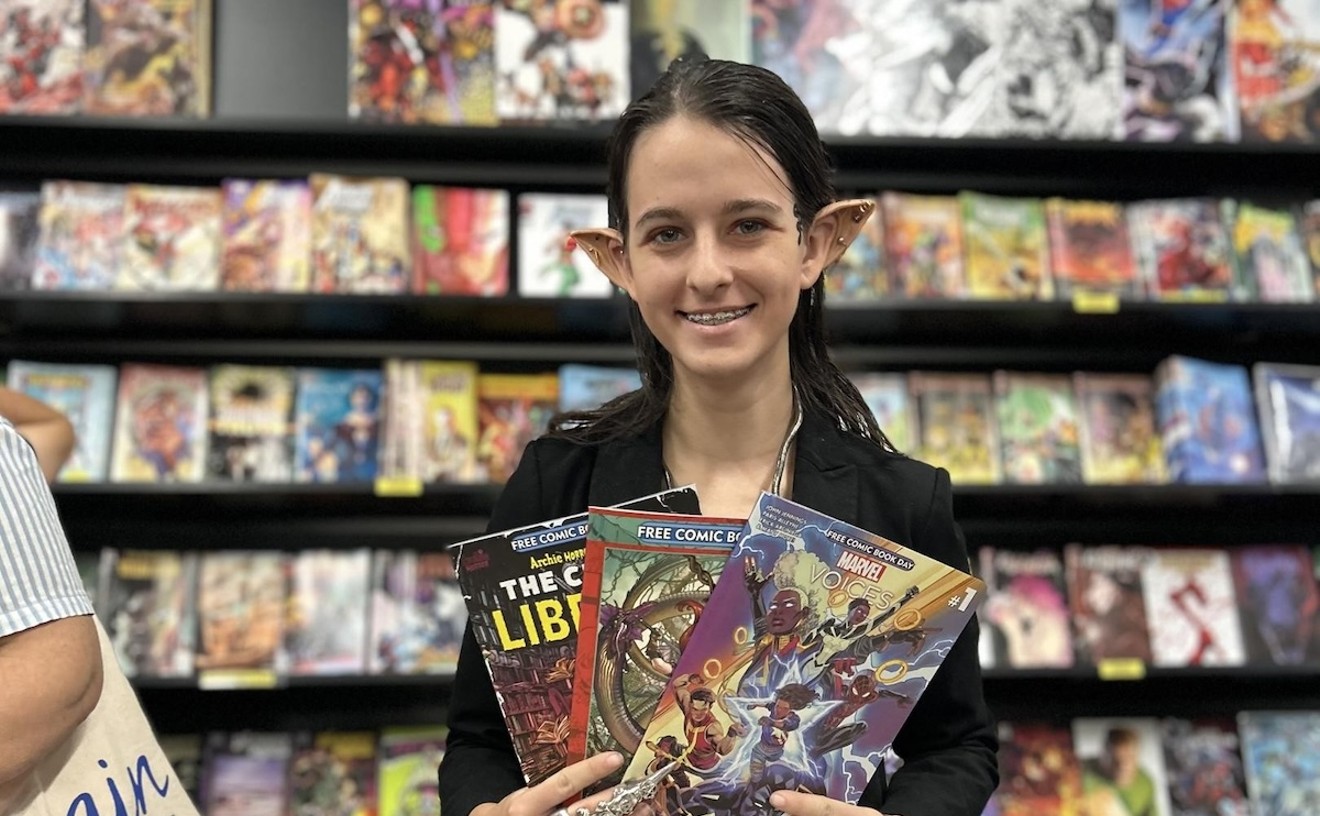Wolfgang Roth strides across his Design District gallery on a recent Wednesday afternoon, stopping abruptly in front of a striking bronze sculpture. The bust, of an African queen from the kingdom of Benin, is more than 350 years old. It's part of a new show that Roth is especially proud of; it marks the first time this rare collection of African bronzes has been assembled for public viewing in the United States outside a museum.
He gingerly strokes the sculpture as several assistants scurry around him, hanging photos for the Africa-centric exhibit, which is just days from opening. Roth, who is tall and slender with salt-and-pepper-hair, watches them quietly.
"One of my passions has been African art, which I have been collecting the past 25 years," he nearly whispers. "I've wanted to organize an exhibition for some time now showing the diversity of African culture from different views."
The result is "Africa," a new exhibit at Wolfgang Roth & Partners Fine Art. It is an engaging, surprising show — a bold mélange of work reflecting African culture from contrasting perspectives. The exhibit is organized in three parts, ranging from Benin bronzes dating back more than 500 years, to modern studio photography by three African artists, to the work of two Westerners influenced by the people and historical legacy of the continent.
The show is built around the Benin bronzes: close to 40 stunning works created between the 12th and 19th centuries in Nigeria. The bulk of the sculptures comes from the estate of Paul Garn, a wine merchant from Dresden, Germany, who began collecting them in the 1920s and 1930s in Paris. Roth acquired the collection two years ago.
How the works ended up in Miami is a story unto itself. The forest kingdom of Benin (now part of Nigeria), among the longest-enduring powers in Africa, was known for its artistic creativity. Benin sculptors developed a high level of realism and stylization of detail and ornament in their work, which early on focused on recounting historical events and rulers of society. It became one of the most influential art traditions in West Africa, spreading throughout the cultures straddling the Niger River.
For colonizers, the kingdom was one of the most difficult to subdue on the African continent, but the British ruthlessly dismantled the Benin state in 1897. Nearly a thousand of the magnificent sculptures and plaques that lined the walls of the kingdom's royal palace were looted and sent to London. Many works ended up in the British Museum, and others were divided among diverse collections.
The treasures on display at Roth & Partners depict typical monarchs, animals, warriors, and scenes of courtly life such as acrobats entertaining royalty, bird hunts, and a ritual sacrifice. The sculptures and relief plaques are arranged on pedestals at the entrance of the gallery in a room painted blood red, hinting at the decimation that the slave trade inflicted.
Although the exquisite museum-quality bronzes alone merit a visit to the gallery, the eclectic photographic works are the show's beating heart.
The didactic nature of the photographs, which open a rare window onto a lost culture, offer a remarkable educational opportunity for schools, especially considering that the spectacular exhibition coincides with Black History Month.
In the section focused on contemporary African photography, the gallery showcases the works of Malick Sidibé, Philip Kwame Apagya, and Samuel Fosso.
Considered by many to be the godfather of modern African photography, Sidibé is one of the first African studio photographers recognized by the Western world for his black-and-white studies of popular culture in the 1960s.
The photos, taken at parties and nightclubs, as well as on the streets of Bamako, exude an intensity and authenticity heightened by odd angles reminiscent of a paparazzi snatch-and-grab.
Often taken in closeup, Sidibé's images place the viewer at the center of the action, where one can almost hear the air filled with music or echoes of laughter in a spontaneous, carefree, and disarming manner.
Ghana native Apagya creates photos that feature brightly painted backdrops in front of which he poses his subjects in faux trappings of luxury suggestive of global consumerism.
In Ghetto Blaster, a smiling young woman wearing flip-flops and a turquoise and black print frock looks over her shoulder at the spectator while holding a boombox aloft. Behind her, a colorful backdrop depicts an entertainment console spilling over with a large-screen TV set, a stereo, and other expensive electronic equipment.
Likewise, in Come on Board, a woman peers back at the viewer as she is about to board a flight on a Ghana International Airlines jet in a scene that in reality might be beyond her means. Her imagined jaunt tugs at the heart, evoking visions of champagne wishes and caviar dreams.
Peter Beard and Leni Riefenstahl, the Westerners in this show, arguably have the most interesting and controversial backstories.
Beard, whose great-grandfather G. G. Hill was a railroad baron who amassed a $53 million fortune before he died, is best known for capturing Kenya's vast, unspoiled Tsavo National Park with famous Danish author Isak Dinesen (Karen Blixen) of Out of Africa fame.
Born in 1938, Beard moved to Kenya's Ngong Hills near East Africa after graduating from Yale University with an art history degree, purchasing the farm neighboring Blixen's.
Over the years, Beard has observed the once-colonial, tribal population of just fewer than five million, from his first visit in 1955, explode into today's resource-draining population of 30 million.
He has also documented the diminishing pockets of animal habitat he once thought impenetrable, including the relentless demise of 35,000 elephants and 5,000 black rhinos in the first two of a number of books about his African experience: The End of the Game in 1965 and 1977.
One of the most arresting works on display at the gallery is Beard's Tsavo North on the Athi Tiva (1965).
The large gelatin silver print features an extreme closeup of a bull elephant raising its tusks. To the right of the majestic beast, a series of smaller photos depicts a rhino charging a man. Ironically, Beard himself survived being gored and trampled by an elephant in 1996.
Hands down, the most breathtaking works exhibited here are Reifensthal's pictures of the mysterious Nuba tribe.
From 1962 until 1977, Riefenstahl became the first white woman to live among the tribe, with special permission from the Sudanese government. She studied their way of life and recorded it on film. The images are haunting and unforgettable. Her two international best-selling books about the Nuba, published in the early 1970s, captured a people whose customs were being threatened by the inexorable advance of civilization.
Riefenstahl, who had long been discredited as a Hitler-besotted Nazi propagandist for her films extolling the grandeur of the Third Reich, earned a measure of rehabilitation for her work with the Nuba.
At Roth & Partners, it's difficult to ignore that even though Riefenstahl — whose Nazi epics, Triumph of the Will and Olympia, are still considered the best movies ever helmed by a female director — might have been a political idiot, she sure was a great artist.
It's also hard to deny that Wolfgang Roth has delivered a daring show that offers plenty to debate about.










